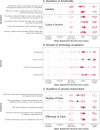Evaluation of remote digital postoperative wound monitoring in routine surgical practice
- PMID: 37147462
- PMCID: PMC10161985
- DOI: 10.1038/s41746-023-00824-9
Evaluation of remote digital postoperative wound monitoring in routine surgical practice
Abstract
Remote digital postoperative wound monitoring provides an opportunity to strengthen postoperative community care and minimise the burden of surgical-site infection (SSI). This study aimed to pilot a remote digital postoperative wound monitoring service and evaluate the readiness for implementation in routine clinical practice. This was a single-arm pilot implementational study of remote digital postoperative wound monitoring across two tertiary care hospitals in the UK (IDEAL stage 2b, clinicaltrials.gov: NCT05069103). Adults undergoing abdominal surgery were recruited and received a smartphone-delivered wound assessment tool for 30-days postoperatively. Patients received 30-day postoperative follow-up, including the Telehealth Usability Questionnaire (TUQ). A thematic mixed-methods approach was used, according to the WHO framework for monitoring and evaluating digital health interventions. 200 patients were enroled, of whom 115 (57.5%) underwent emergency surgical procedures. Overall, the 30-day SSI rate was 16.5% (n = 33/200), with 72.7% (n = 24) diagnosed post-discharge. Usage of the intervention was 83.0% (n = 166/200), with subsequently 74.1% (n = 123/166) TUQ completion. There were no issues reported with feasibility of the technology, with the reliability (3.87, 95% CI: 3.73-4.00) and quality of the interface rated highly (4.18, 95%: 4.06-4.30). Patient acceptance was similarly high with regards to ease of use (4.51, 95% CI: 4.41-4.62), satisfaction (4.27, 95% CI: 4.13-4.41), and usefulness (4.07, 95% CI: 3.92-4.23). Despite the desire for more frequent and personalised interactions, the majority viewed the intervention as providing meaningful benefit over routine postoperative care. Remote digital postoperative wound monitoring successfully demonstrated readiness for implementation with regards to the technology, usability, and healthcare process improvement.
© 2023. The Author(s).
Conflict of interest statement
The authors declare no competing interests.
Figures



Similar articles
-
Enhancing Surgical Wound Monitoring: A Paired Cohort Study Evaluating a New AI-Based Application for Automatic Detection of Potential Infections.J Clin Med. 2024 Dec 23;13(24):7863. doi: 10.3390/jcm13247863. J Clin Med. 2024. PMID: 39768786 Free PMC article.
-
Remote diagnosis of surgical-site infection using a mobile digital intervention: a randomised controlled trial in emergency surgery patients.NPJ Digit Med. 2021 Nov 18;4(1):160. doi: 10.1038/s41746-021-00526-0. NPJ Digit Med. 2021. PMID: 34795398 Free PMC article.
-
Remote assessment of surgical site infection (SSI) using patient-taken wound images: Development and evaluation of a method for research and routine practice.J Tissue Viability. 2023 Feb;32(1):94-101. doi: 10.1016/j.jtv.2023.01.001. Epub 2023 Jan 10. J Tissue Viability. 2023. PMID: 36681617 Free PMC article. Review.
-
Inter-rater agreement and checklist validation for postoperative wound assessment using smartphone images in vascular surgery.J Vasc Surg Venous Lymphat Disord. 2016 Jul;4(3):320-328.e2. doi: 10.1016/j.jvsv.2016.02.001. Epub 2016 Mar 26. J Vasc Surg Venous Lymphat Disord. 2016. PMID: 27318052 Free PMC article.
-
Developing a mobile health application for wound telemonitoring: a pilot study on abdominal surgeries post-discharge care.BMC Med Inform Decis Mak. 2023 Jun 2;23(1):103. doi: 10.1186/s12911-023-02199-z. BMC Med Inform Decis Mak. 2023. PMID: 37268995 Free PMC article. Review.
Cited by
-
Digitising wound care: a cost-consequence analysis of the Wound Care Command Centre™ in Australia.BMC Health Serv Res. 2025 Jul 1;25(1):873. doi: 10.1186/s12913-025-12969-2. BMC Health Serv Res. 2025. PMID: 40598094 Free PMC article.
-
An international consensus panel on the potential value of Digital Surgery.BMJ Open. 2024 Sep 5;14(9):e082875. doi: 10.1136/bmjopen-2023-082875. BMJ Open. 2024. PMID: 39242163 Free PMC article.
-
Pioneering sustainable treatment delivery in childhood leukemia through synchronous telemedicine-A pilot study.Int J Cancer. 2025 Mar 15;156(6):1247-1255. doi: 10.1002/ijc.35253. Epub 2024 Nov 9. Int J Cancer. 2025. PMID: 39520275 Free PMC article.
-
Enhancing Surgical Wound Monitoring: A Paired Cohort Study Evaluating a New AI-Based Application for Automatic Detection of Potential Infections.J Clin Med. 2024 Dec 23;13(24):7863. doi: 10.3390/jcm13247863. J Clin Med. 2024. PMID: 39768786 Free PMC article.
-
From Prevention to Management: Understanding Postoperative Infections in Gynaecology.Cureus. 2023 Oct 1;15(10):e46319. doi: 10.7759/cureus.46319. eCollection 2023 Oct. Cureus. 2023. PMID: 37916257 Free PMC article. Review.
References
-
- Statista. Smartphone ownership penetration in the United Kingdom (UK) in 2012–2022, By Age. https://www.statista.com/statistics/271851/smartphone-owners-in-the-unit... (2022).
-
- Royal College of Surgeons of England (RCSEng). Future of Surgery (RCSEng, 2018).
-
- World Health Organization (WHO). Policy Brief 47: Addressing Backlogs And Managing Waiting Lists During and Beyond the COVID-19 Pandemic (WHO, 2022). - PubMed
Associated data
Grants and funding
LinkOut - more resources
Full Text Sources
Medical

